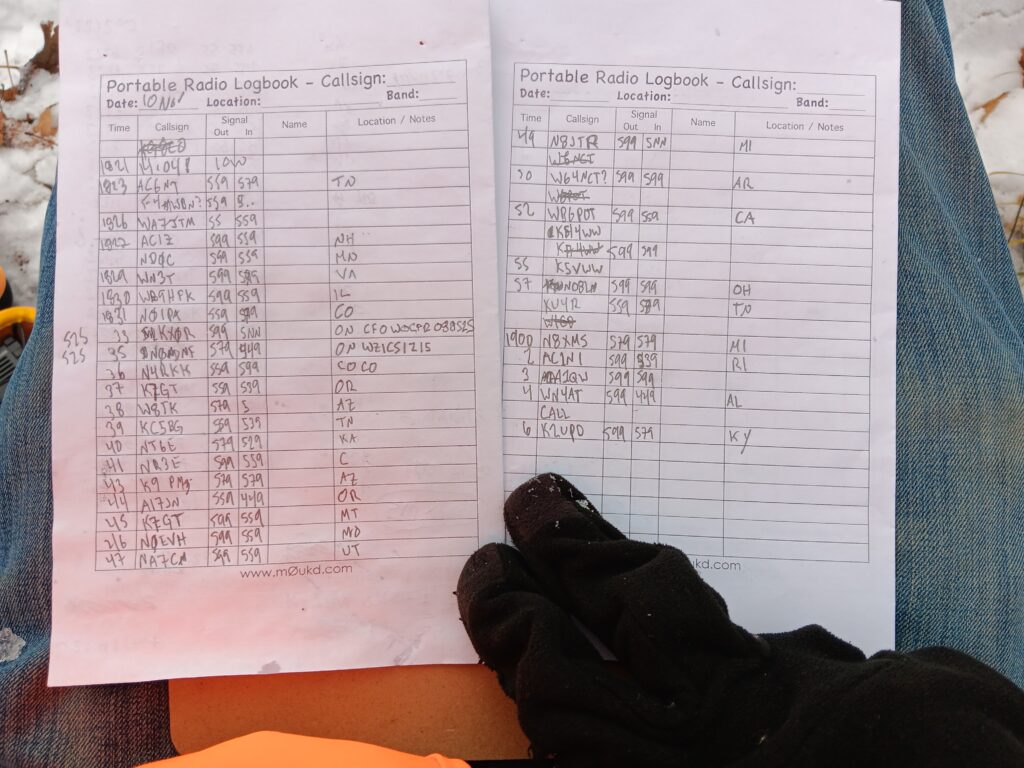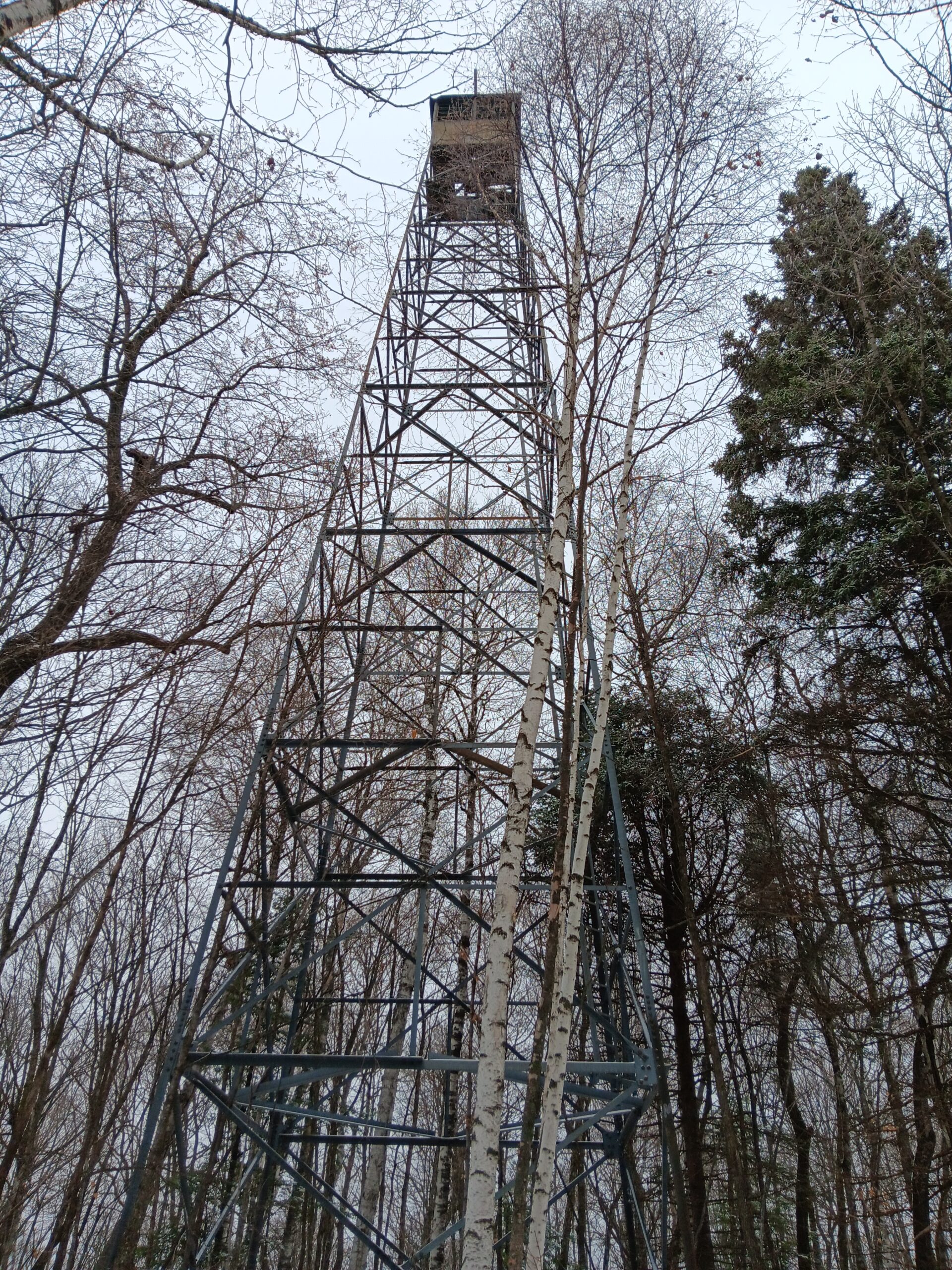Ever since I read through the backlog of KE6MT posts last winter or the winter before, I’ve periodically dropped into sotl.as to zoom around and look at the SOTA opportunities. My area is not rich in them!

I’ve instead focused on POTA for portable operating, but the mountains kept calling. Last Friday (10 November, observed Veterans Day) I had the weird opportunity of a day off work without other obligations. I had an itch to do something completely fun and irresponsible. So I planned my first activation for K0M/CW-001, Height of Land Lookout, the nearest summit, two hours east of QTH.
As a bonus, this summit is inside K-4836, White Earth State Forest! And on the way are K-0369, Rydell National Wildlife Refuge, and K-0360, Glacial Ridge National Wildlife Refuge.
Although I didn’t manage to activate because of eventual time constraints, I’ll explain what a “glacial ridge” is doing in a place with no mountains. 8,000 to 13,000 years ago, there was a lake in this area at the forefront of continental glaciers reaching down from Canada. Before this time, these massive ice sheets had extended farther south, and during their retreat (warming caused the front of the glaciers to melt, even though the ice still flowed from north to south), the water pooled up in what is now the Red River valley (the blue line intersecting Fargo and Grand Forks on the map above). Glaciers are heavy, and in this area the weight had squashed the ground just enough to allow the lake to build up. What do you get at the bottom of lakes? Mud, which remains wonderfully fertile soil today. And what do you get on the edges of lakes? Sand beaches–in this case, still visible in the form of the ridges in this area.
That was far more than I intended to write.
A pleasant drive on a dreary day brought me to a narrow dirt road that leads almost directly to Height of Land Lookout, and old fire tower location. The fresh snow on the road showed a fair bit of hunting traffic, and I was glad to have stopped and grabbed a blaze orange hat and vest on the way out of town. I didn’t see anyone all day, though.

The hike up the hill was short and relatively easy. I chose to leave the vehicle on the road. The tower is much bigger than I expected! If I hadn’t been alone, it would have been a neat climb to the top, but perhaps I’m more cautious now than I used to be.

I carried a camping chair with me and set it up in a small clearing on what looked like the tippety-top of the hill, and operated sitting in the chair, my radio on my lap, and log and paddles on a clipboard. Equipment:
- Xiegu X6100
- TufteLn EFHW antenna
- Small 12V lead-acid battery
- CW Morse paddles
- Log sheets by M0UKD

I operated on 20 m at 10W because I didn’t want to hang around all day at 5W, but I shouldn’t have worried. I had scheduled SOTA and POTA activations, so RBN must have picked me up when I started calling CQ, and it felt like I didn’t stop for 40 minutes. There were gaps, but in the end I had to call it off because my fingers were too cold (it was 30F) to key and write well anymore [TODO: 1) get some gloves that I can key in 2) learn to key left-handed and write right-handed]. I’m sorry for anyone I left out at the end. Thirty contacts in 36 minutes kept me distracted that I didn’t feel the cold seeping in until far too late.

It was exciting to finally get some SOTA points, and I’m already looking around for other places to go…

The second POTA of the day was at Rydell National Wildlife Refuge, and it was a very different activation. I drove in, found a spot to park, and set up the AX-1 antenna using a suction cup mount that originally came with my RTL-SDR dongle. Worked great! I started again on 20 m and, because it makes no sense, started at 5W for the first four contacts and then 10W for the rest. Eleven contacts in half an hour, then back on the road.

Last thoughts?
- I probably rely on the external battery pack more than I need to with this radio, but I’ve also seen the battery drop fast in low temperatures.
- Maybe it’s worth buying a smaller external battery…
- Even with all the time in the world, I still don’t like moving from band to band. This time I didn’t need to, I had more people piled up than I knew what to do with.
- I think I handled the pileups OK, with fewer and fewer ??? every activation.
- Glad to know the AX-1 works in a pinch. I haven’t tried it as my only antenna much, only as a backup.
- Now that I’m more comfortable with all this stuff, I should take the FT-818ND out and try to activate with it. Sometimes the X6100 seems to be a bit much, but I’m getting used to the minimal settings I typically need to change.
- Again, really fun to finally do SOTA!
Thanks for reading!

Hello, and I enjoyed reading your “Activation diary.” I’ll offer a couple of comments, based on my POTA experiences. (1) Your “camping chair in the snow” photo is missing an important item: Give yourself a closed-cell foam pad for your feet to rest upon. If I’m losing body heat into the ground via my feet, then my handwriting and my CW fist really suffer as a result. (2) If you’re still using a lead-acid battery, try hunting down a used 12V LiPo battery from a laptop computer. I’m using some “77 watt-hour” batteries that came out of old MacBook laptops (roughly 2010-2012 vintage), and one battery will power my HW-8 (2 mighty watts of RF) for an entire Field Day with charge to spare. If you do this, please contact me about the charger that I use with these batteries. (3) I like center-fed dipoles with a ferrite common-mode choke on the coax near the feedpoint – I’m not reliant on an earth ground, in the way that an EFHW is.
Best of luck to you in your future activations! – WB9CYY